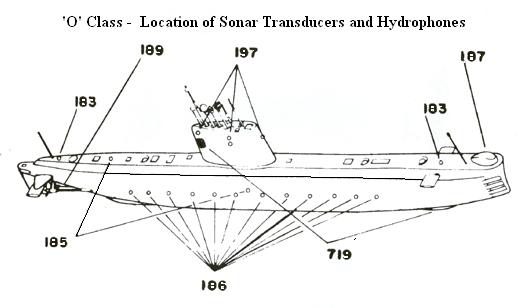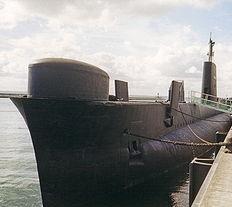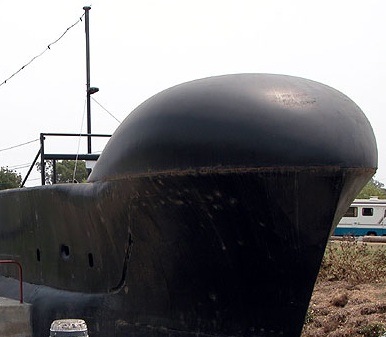 |
| 'O' class sonar and sensor locations. (Graphic courtesy Canadian Navy) |
| INITIAL 'O' CLASS SONAR SETS | ||||
| TYPE | TITLE | USE | REMARKS | ACQUISITION RANGE |
| 183 |
|
Emergency underwater telephone for submarine S.A.R. | Battery operated. Transmit - 12 hours. Receive - 72 hours | 1,000 yards |
| 185 | Sea Talk | Underwater
Telephone |
Narrow beam by integration with Type 187 | (a) 7,000 yards
(b)11,000 yards |
| 186 | Searcher | Long Range Search | Submarine requires maximum self quiet. | 60 miles |
| 187 | Attacker | Medium Range Search
Attack set Active mode |
(1) Used for mine detection
(2) Use transducer with type 185 |
Up to 22,000 yards |
| 189 | Monitor | Self noise monitor | Located by propellers | -- |
| 197 | Watcher | Surface intercept sonar | Has bearing indicator and frequency analyzer | -- |
| 719 | Scanner | Torpedo warning screen Penetration | Video presentation and CRT display. | 6 to 8,000 yards. |
The above table was copied from a Canadian Navy Training Manual. Between the table and the text, there are some shortcomings in the explanations.
 |
| 'O' class sonar and sensor locations. (Graphic courtesy Canadian Navy) |
Type 183 is the emergency underwater telephone used only for submarine disasters. It is battery powered, operates in the 8 to 9 Khz band and has a range of 1,000 yards. It was known as the "Say Again machine" by many of its users.Type 185 is the main underwater communication set. It has three transducers each with a 120 degree beam width. One is mounted on the casing looking upward and one each in the port and starboard tanks. The set can be integrated with type 187 to give a 12 degree directional beam.
Type 186 is a long range passive sonar. It consists of 48 hydrophones mounted in high and low frequency pairs on either side of the submarine. This line array of hydrophones suffers less attenuation loss than the directional transducers of other sets which operate on higher basic frequencies. To operate the set, the submarine reduced to the maximum self quiet state (ultra quiet) and swept from side to side usually about 16 to 20 degrees per minute.
The operator's console has a pen recording display which is activated by a noise on the beam bearing of the submarine It produces a deflection trace from a normal position. Bearing accuracy is obtained by a "cut on" and "cut off" principle utilizing the whole array for reception.
Type 187 is a medium range search sonar and is also the submarine's attack sonar. Using a frequency of 2.5 KHz, it has an active capability of hand transmission at fixed intervals of 1,000 and 2,000 yards. The limitations of this set are susceptibility to high self induced noise, poor stern arc coverage and loss of detection when firing torpedoes (This was reduced with the use of "swim out" torpedoes. The set has a bearing accuracy either 1/2 or 1 degree depending on the mode of operation.
The sensitivity of the set falls off at very low frequencies but it remains constant down to about 200 Hz. In the active mode ranges out to 7,000 ft or yards (?) can be obtained. A single transmission ping can sometimes be used to check target range prior to firing a torpedo.
Type 189 - This is a self noise monitor hydrophone that was used by the OOW to ensure that the submarine's propellors are not cavitating.
Type 197 is the intercept sonar set. It operates within the frequency range 3 to 40 KHz and is designed to analyze active sonar transmissions and give a visual indication of the source. This bearing has limited accuracy. As with all sonars, there is a best listening depth for interceptions.
Type 719 is a short range passive sonar whose primary function is torpedo warning and screen penetration. A high scan rate of 12 rpm is useful for continual close-target information. Two displays are fitted - a PPI display in the Soundroom and a remote linear bearing paper recorder.
Having two hydrophones, the stern arc is constantly swept; the normal mode of operation is to have the hydrophones in unison cutting in and out on the beam. The set's limitations are:
a) A low detection range due to its high operating frequency.
b) Very susceptible to self noise especially when snorkelling.
c) Other sonar transmissions blank out a lot of the detection capability, particularly long pulse transmissions.
d) Poor bearing accuracy; +/- 20 degrees at long ranges but accuracy increases as target intensity increases.The type 719 can be integrated with type 187 and could be operated at 12.5, 15.25 or 17.75 KHz as required. The advantage of this method is to increase bearing accuracy and discrimination . The 187 transducer is linked to the 719 display in this integration.
Type 773 deep echo sounder. Range down to 1,000 fathoms
Type 776 shallow echo sounder. Range down to 1,000 fathoms
Both of the above are 'active' fixing aids which required a transmission from the submarine, therefore no one could use the echo sounders without the approval of the Commanding Officer.Bathythermograph (Initial). Two, type AN/BQN-1B sonar sounding sets were fitted in the Oberons and used as "bathys". One sensing element was located in the keel and the other on the top of the fin. These bathys were velocimeters. They measured the velocity of sound in the water around the sensing element. This information obtained was used in deciding the best listening depth or best evasion depth for the submarine. It also indicated to the trimming OOW, if he could expect to be heavy or light as he changed depth due to the change in water density outside the submarine. It could range up to 1200 feet above or below the submarine. The BQN operated on 70 kHz and had pulse repetition rates of 40 per second ( up to 30 feet); 4 per second up to 300 feet and 1 per second up to 1,200 feet.
 |
| AN/BQN-1. The output power was 0 to 5 watts. (Graphic courtesy USN via HNSA) |
Tape Recorder - To assist the Sonar Operator with classification of echoes, a three speed Philips was provided in the Soundroom. The operator recorded a Hydrophone Effect (HE) at high speed from all sets and particularly the attacker set in all frequency modes. The tape was then played back at slow speed to allow for a more accurate evaluation of:a) Number of propellers
b) blade rate
c) Type of propulsion ( ie diesel, reciprocating or steam turbine)
d) Revolution count
e) In/out effect
FINAL FIT SONARS and SENSORS
(May be incomplete)
Type 773 deep echo sounder. Range down to 1,000 fathoms
Type 776 shallow echo sounder. Range down to 1,000 fathoms
Type 183 emergency underwater telephone
Type 189 cavitation monitor for self noise monitoring and analysis
Type 2051 Plessey Triton passive-active search and attack.
Bathythermograph Type 2004 bathythermograph Mk 8 expendable bathythermographs were installed.
AN/BOG-502 "Ranger" Sperry Micro-puffs; passive ranging. Provides target course, speed and range data
AN/ WQQ-501 underwater telephone
SUBTASS combined towed array and flank array; long-range passive search.
VELOX active sonar intercept and analysis
 |
 |
| 187 Dome (Photo via Don Courcy) | This is believed to be the Plessey 2051 dome. (Photo via Don Courcy) |
Contributors and Credits:1) Don Courcy VE2CW <ve2cw(at)rac.ca> Web http://www.radioman.ca
2) The Canadian Submarine Service in Review by J. David Perkins
3) RCN C.F. 'O' Class Submarine Training Notebook - Chapter 14, Operations Equipment Circa, late 1960's and 70's.
4) AN/BQN1 graphic HNSA http://www.hnsa.org/doc/ecat/cat-0091.htmJul 23/11